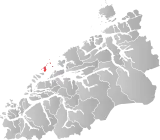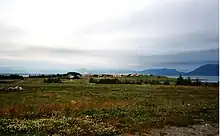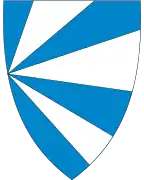Sandøy Municipality
Sandøy kommune | |
|---|---|
| Sandø herred (historic name) | |
 View of the village of Ona | |
 Flag | |
 Møre og Romsdal within Norway | |
 Sandøy within Møre og Romsdal | |
| Coordinates: 62°45′40″N 06°27′5″E / 62.76111°N 6.45139°E | |
| Country | Norway |
| County | Møre og Romsdal |
| District | Romsdal |
| Established | 1 Jan 1867 |
| • Preceded by | Akerø Municipality |
| Disestablished | 1 Jan 2020 |
| • Succeeded by | Ålesund and Aukra |
| Administrative centre | Steinshamn |
| Government | |
| • Mayor (2015-2019) | Oddvar Myklebust (Ap) |
| Area (upon dissolution) | |
| • Total | 21.43 km2 (8.27 sq mi) |
| • Land | 21.36 km2 (8.25 sq mi) |
| • Water | 0.07 km2 (0.03 sq mi) 0.3% |
| • Rank | #416 in Norway |
| Population (2018) | |
| • Total | 1,263 |
| • Rank | #371 in Norway |
| • Density | 59.1/km2 (153/sq mi) |
| • Change (10 years) | |
| Demonym | Sandøying[1] |
| Official language | |
| • Norwegian form | Nynorsk |
| Time zone | UTC+01:00 (CET) |
| • Summer (DST) | UTC+02:00 (CEST) |
| ISO 3166 code | NO-1546[3] |
Sandøy is a former municipality in Møre og Romsdal county, Norway. It was part of the Romsdal region. The administrative centre was the village of Steinshamn. Other villages included Ona and Myklebost. The municipality was spread out over many islands in the mouth of the vast Romsdal Fjord. The Flatflesa Lighthouse and Ona Lighthouse protect the boats traveling around the municipality. The Nordøy Fixed Link project was constructed from 2018 until 2023 and it includes three undersea tunnels and several bridges that will connect the main islands of Sandøy Municipality and the islands of Haram Municipality to the mainland.[4]
At the time if its dissolution in 2020, the 21-square-kilometre (8.1 sq mi) municipality is the 416th largest by area out of the 422 municipalities in Norway. Sandøy is the 371st most populous municipality in Norway with a population of 1,263. The municipality's population density is 59.1 inhabitants per square kilometre (153/sq mi) and its population has decreased by 1.4% over the last decade.[5][6]
General information



The municipality of Sandø i Romsdal was established on 1 January 1867 when it was separated from Akerø Municipality. The initial population was 601. The spelling of the name was later changed to Sandøy. During the 1960s, there were many municipal mergers across Norway due to the work of the Schei Committee. On 1 January 1965, the Myklebost area on Harøya island and some smaller islands to the west (population: 287) were transferred from Haram Municipality to Sandøy Municipality.[7]
On 1 January 2020, the municipality of Sandøy was dissolved. The islands of Orta and Lyngværet (and the small surrounding islands) were merged into Aukra Municipality.[8] The remainder of the old Sandøy Municipality was merged with Haram Municipality, Ørskog Municipality, Skodje Municipality, and Ålesund Municipality to form one large municipality of Ålesund.[9]
Name
The municipality (originally the parish) is named after the farm and small island of Sandøya (Old Norse: Sandøy) since the first Sandøy Church was built there. The first element comes from the word sandr which means "sand". The last element is øy which means "island".[10] Historically, the name of the municipality was spelled Sandøen or Sandø. On 3 November 1917, a royal resolution changed the spelling of the name of the municipality to Sandøy.[11]
Coat of arms
The coat of arms was granted on 12 December 1986 and they were in use until the municipality was dissolved on 1 January 2020. The official blazon is "Azure, three piles conjoined in dexter argent" (Norwegian: I blått tre sølv spissar som møtest i høgre skjoldrand). This means the arms have a blue field (background) and the charge is a three triangles conjoined at a point along the left side. The charge has a tincture of argent which means it is commonly colored white, but if it is made out of metal, then silver is used. The design is meant to mimic the light beams from the Ona Lighthouse. This was chosen since lighthouses play an important role in the safety in the municipality, which consists of 871 islands and skerries. The arms were designed by Astor Furseth. The municipal flag has the same design as the coat of arms.[12][13][14]
Churches
The Church of Norway had one parish (sokn) within the municipality of Sandøy. It was part of the Molde domprosti (arch-deanery) in the Diocese of Møre.
| Parish (sokn) | Church name | Location of the church | Year built |
|---|---|---|---|
| Sandøy | Sandøy Church | Sandøya | 1812 |
| Harøy Church | Harøya | 1934 |
Geography
Sandøy was an island municipality. Sandøy consisted of 871 islands, but only five were regularly inhabited by the time the municipality was dissolved. The main inhabited islands were Harøya, Sandøya, Finnøya, Ona, and Orta. Ona is the most famous of the islands and is a popular tourist destination due to its history and the Ona Lighthouse.
Government
While it existed, this municipality was responsible for primary education (through 10th grade), outpatient health services, senior citizen services, unemployment, social services, zoning, economic development, and municipal roads. During its existence, this municipality was governed by a municipal council of directly elected representatives. The mayor was indirectly elected by a vote of the municipal council.[15] The municipality fell under the Romsdal District Court and the Frostating Court of Appeal.
Municipal council
The municipal council (Kommunestyre) of Sandøy is made up of 19 representatives that are elected to four year terms. The party breakdown for the final municipal council was as follows:
| Party name (in Nynorsk) | Number of representatives | |
|---|---|---|
| Labour Party (Arbeidarpartiet) | 10 | |
| Conservative Party (Høgre) | 6 | |
| Liberal Party (Venstre) | 3 | |
| Total number of members: | 19 | |
| Party name (in Nynorsk) | Number of representatives | |
|---|---|---|
| Labour Party (Arbeidarpartiet) | 6 | |
| Progress Party (Framstegspartiet) | 1 | |
| Conservative Party (Høgre) | 7 | |
| Liberal Party (Venstre) | 5 | |
| Total number of members: | 19 | |
| Party name (in Nynorsk) | Number of representatives | |
|---|---|---|
| Labour Party (Arbeidarpartiet) | 6 | |
| Progress Party (Framstegspartiet) | 1 | |
| Conservative Party (Høgre) | 6 | |
| Christian Democratic Party (Kristeleg Folkeparti) | 2 | |
| Liberal Party (Venstre) | 4 | |
| Total number of members: | 19 | |
| Party name (in Nynorsk) | Number of representatives | |
|---|---|---|
| Labour Party (Arbeidarpartiet) | 3 | |
| Conservative Party (Høgre) | 10 | |
| Christian Democratic Party (Kristeleg Folkeparti) | 2 | |
| Liberal Party (Venstre) | 2 | |
| Cross-party list for Sandøy (Tverrpolitisk liste for Sandøy) | 2 | |
| Total number of members: | 19 | |
| Party name (in Nynorsk) | Number of representatives | |
|---|---|---|
| Labour Party (Arbeidarpartiet) | 3 | |
| Conservative Party (Høgre) | 6 | |
| Christian Democratic Party (Kristeleg Folkeparti) | 4 | |
| Liberal Party (Venstre) | 2 | |
| Cross-party list (Tverrpolitisk liste) | 4 | |
| Total number of members: | 19 | |
| Party name (in Nynorsk) | Number of representatives | |
|---|---|---|
| Labour Party (Arbeidarpartiet) | 7 | |
| Conservative Party (Høgre) | 5 | |
| Christian Democratic Party (Kristeleg Folkeparti) | 4 | |
| Centre Party (Senterpartiet) | 2 | |
| Liberal Party (Venstre) | 1 | |
| Total number of members: | 19 | |
| Party name (in Nynorsk) | Number of representatives | |
|---|---|---|
| Labour Party (Arbeidarpartiet) | 5 | |
| Conservative Party (Høgre) | 5 | |
| Christian Democratic Party (Kristeleg Folkeparti) | 4 | |
| Centre Party (Senterpartiet) | 2 | |
| Liberal Party (Venstre) | 3 | |
| Total number of members: | 19 | |
| Party name (in Nynorsk) | Number of representatives | |
|---|---|---|
| Labour Party (Arbeidarpartiet) | 4 | |
| Conservative Party (Høgre) | 5 | |
| Christian Democratic Party (Kristeleg Folkeparti) | 3 | |
| Centre Party (Senterpartiet) | 2 | |
| Joint list of the Liberal Party (Venstre) and Liberal People's Party (Liberale Folkepartiet) |
5 | |
| Total number of members: | 19 | |
| Party name (in Nynorsk) | Number of representatives | |
|---|---|---|
| Labour Party (Arbeidarpartiet) | 3 | |
| Conservative Party (Høgre) | 3 | |
| Christian Democratic Party (Kristeleg Folkeparti) | 4 | |
| Liberal People's Party (Liberale Folkepartiet) | 1 | |
| Centre Party (Senterpartiet) | 4 | |
| Liberal Party (Venstre) | 1 | |
| Non-party election list (Upolitisk valliste) | 3 | |
| Total number of members: | 19 | |
| Party name (in Nynorsk) | Number of representatives | |
|---|---|---|
| Labour Party (Arbeidarpartiet) | 3 | |
| Conservative Party (Høgre) | 4 | |
| Christian Democratic Party (Kristeleg Folkeparti) | 4 | |
| Centre Party (Senterpartiet) | 3 | |
| Joint list of the Liberal Party (Venstre) and Liberal People's Party (Liberale Folkepartiet) |
2 | |
| Non-party election list (Upolitisk valliste) | 3 | |
| Total number of members: | 19 | |
| Party name (in Nynorsk) | Number of representatives | |
|---|---|---|
| Labour Party (Arbeidarpartiet) | 3 | |
| Conservative Party (Høgre) | 1 | |
| Christian Democratic Party (Kristeleg Folkeparti) | 5 | |
| New People's Party (Nye Folkepartiet) | 1 | |
| Centre Party (Senterpartiet) | 5 | |
| Non-party election list (Upolitisk Valliste) | 4 | |
| Total number of members: | 19 | |
| Party name (in Nynorsk) | Number of representatives | |
|---|---|---|
| Labour Party (Arbeidarpartiet) | 4 | |
| Christian Democratic Party (Kristeleg Folkeparti) | 4 | |
| Centre Party (Senterpartiet) | 6 | |
| Liberal Party (Venstre) | 2 | |
| Local List(s) (Lokale lister) | 3 | |
| Total number of members: | 19 | |
| Party name (in Nynorsk) | Number of representatives | |
|---|---|---|
| Christian Democratic Party (Kristeleg Folkeparti) | 4 | |
| Liberal Party (Venstre) | 1 | |
| Local List(s) (Lokale lister) | 14 | |
| Total number of members: | 19 | |
| Party name (in Nynorsk) | Number of representatives | |
|---|---|---|
| Local List(s) (Lokale lister) | 17 | |
| Total number of members: | 17 | |
| Party name (in Nynorsk) | Number of representatives | |
|---|---|---|
| Local List(s) (Lokale lister) | 17 | |
| Total number of members: | 17 | |
| Party name (in Nynorsk) | Number of representatives | |
|---|---|---|
| Local List(s) (Lokale lister) | 17 | |
| Total number of members: | 17 | |
| Party name (in Nynorsk) | Number of representatives | |
|---|---|---|
| Local List(s) (Lokale lister) | 16 | |
| Total number of members: | 16 | |
| Party name (in Nynorsk) | Number of representatives | |
|---|---|---|
| Local List(s) (Lokale lister) | 16 | |
| Total number of members: | 16 | |
| Party name (in Nynorsk) | Number of representatives | |
|---|---|---|
| Labour Party (Arbeidarpartiet) | 2 | |
| Local List(s) (Lokale lister) | 14 | |
| Total number of members: | 16 | |
| Party name (in Nynorsk) | Number of representatives | |
|---|---|---|
| Labour Party (Arbeidarpartiet) | 3 | |
| Local List(s) (Lokale lister) | 13 | |
| Total number of members: | 16 | |
| Note: Due to the German occupation of Norway during World War II, no elections were held for new municipal councils until after the war ended in 1945. | ||
Mayors
- 1867–1871: Paul Knudsen Gaasø
- 1871–1872: Lars Olsson Sandøy
- 1872–1876: Rasmus Pedersson Huse
- 1876–1877: Gunnar Olsson Sandøy
- 1877–1879: Jonas Knutsson Sandøy
- 1880–1885: Thor Elias Pedersson Huse
- 1886–1887: Knut Paulsson Gåsøy
- 1888–1891: Thor Elias Pedersson Huse
- 1892–1901: Knut Nilsson Finnøy
- 1901–1904: Bernt E. Brunvoll
- 1904–1910: Peder P. Orten
- 1910–1922: Paul I. Huse
- 1922–1925: Elias E. Marøy (V)
- 1925–1928: Peder P. Orten
- 1928–1934: Paul J. Sandøy
- 1934–1941: Elias E. Marøy (V)
- 1941–1943: Nils N. Finnøy
- 1943–1944: Ole P. Husøy
- 1945–1945: Elias E. Marøy (V)
- 1946–1955: Nils K. Finnøy
- 1956–1964: Olav Skotheim (LL)
- 1965–1967: Johan P. Sandøy (LL)
- 1968–1971: Johan P. Sandøy (LL)
- 1972–1975: Johan P. Sandøy (Sp)
- 1976–1979: Tor Huse (LL)
- 1980–1987: Idar Grøtta (Sp)
- 1988–1991: Paul Edmund Steinshamn (DLF/V)
- 1991-1995: Runar Myklebust (H)
- 1995–1999: Oddvar Myklebust (Ap)
- 1999–2007: Nils Magne Abelseth (H)
- 2007–2011: Oddvar Myklebust (Ap)
- 2011–2015: Hans Endre Sæterøy (H)
- 2015-2019: Oddvar Myklebust (Ap)
See also
References
- ↑ "Navn på steder og personer: Innbyggjarnamn" (in Norwegian). Språkrådet.
- ↑ "Forskrift om målvedtak i kommunar og fylkeskommunar" (in Norwegian). Lovdata.no.
- ↑ Bolstad, Erik; Thorsnæs, Geir, eds. (26 January 2023). "Kommunenummer". Store norske leksikon (in Norwegian). Kunnskapsforlaget.
- ↑ "Fv 659 Nordøyvegen" (in Norwegian). Statens vegvesen. Retrieved 19 October 2017.
- ↑ Statistisk sentralbyrå (2018). "Table: 06913: Population 1 January and population changes during the calendar year (M)" (in Norwegian). Retrieved 27 July 2019.
- ↑ Statistisk sentralbyrå. "09280: Area of land and fresh water (km²) (M)" (in Norwegian). Retrieved 27 July 2019.
- ↑ Jukvam, Dag (1999). Historisk oversikt over endringer i kommune- og fylkesinndelingen (PDF) (in Norwegian). Statistisk sentralbyrå. ISBN 9788253746845.
- ↑ "Meir om grensejusteringa i Sandøy" (in Norwegian). Nye Ålesund kommune. Retrieved 27 July 2019.
- ↑ "Nye Ålesund" (in Norwegian). Retrieved 19 October 2017.
- ↑ Rygh, Oluf (1908). Norske gaardnavne: Romsdals amt (in Norwegian) (13 ed.). Kristiania, Norge: W. C. Fabritius & sønners bogtrikkeri. p. 311.
- ↑ "Norsk Lovtidende. 2den Afdeling. 1917. Samling af Love, Resolutioner m.m". Norsk Lovtidend (in Norwegian). Kristiania, Norge: Grøndahl og Søns Boktrykkeri: 1057–1065. 1917.
- ↑ "Civic heraldry of Norway - Norske Kommunevåpen". Heraldry of the World. Retrieved 5 April 2023.
- ↑ "Sandøy, Møre og Romsdal (Norway)". Flags of the World. Retrieved 5 April 2023.
- ↑ "Godkjenning av våpen og flagg". Lovdata.no (in Norwegian). Norges kommunal- og arbeidsdepartementet. 12 December 1986. Retrieved 5 April 2023.
- ↑ Hansen, Tore; Vabo, Signy Irene, eds. (20 September 2022). "kommunestyre". Store norske leksikon (in Norwegian). Kunnskapsforlaget. Retrieved 1 January 2023.
- 1 2 3 4 "Table: 04813: Members of the local councils, by party/electoral list at the Municipal Council election (M)" (in Norwegian). Statistics Norway.
- ↑ "Tall for Norge: Kommunestyrevalg 2011 - Møre og Romsdal" (in Norwegian). Statistics Norway. Retrieved 19 October 2019.
- ↑ "Kommunestyrevalget 1995" (PDF) (in Norwegian). Oslo-Kongsvinger: Statistisk sentralbyrå. 1996. Retrieved 26 April 2020.
- ↑ "Kommunestyrevalget 1991" (PDF) (in Norwegian). Oslo-Kongsvinger: Statistisk sentralbyrå. 1993. Retrieved 26 April 2020.
- ↑ "Kommunestyrevalget 1987" (PDF) (in Norwegian). Oslo-Kongsvinger: Statistisk sentralbyrå. 1988. Retrieved 26 April 2020.
- ↑ "Kommunestyrevalget 1983" (PDF) (in Norwegian). Oslo-Kongsvinger: Statistisk sentralbyrå. 1984. Retrieved 26 April 2020.
- ↑ "Kommunestyrevalget 1979" (PDF) (in Norwegian). Oslo: Statistisk sentralbyrå. 1979. Retrieved 26 April 2020.
- ↑ "Kommunevalgene 1975" (PDF) (in Norwegian). Oslo: Statistisk sentralbyrå. 1977. Retrieved 26 April 2020.
- ↑ "Kommunevalgene 1972" (PDF) (in Norwegian). Oslo: Statistisk sentralbyrå. 1973. Retrieved 26 April 2020.
- ↑ "Kommunevalgene 1967" (PDF) (in Norwegian). Oslo: Statistisk sentralbyrå. 1967. Retrieved 26 April 2020.
- ↑ "Kommunevalgene 1963" (PDF) (in Norwegian). Oslo: Statistisk sentralbyrå. 1964. Retrieved 26 April 2020.
- ↑ "Kommunevalgene og Ordførervalgene 1959" (PDF) (in Norwegian). Oslo: Statistisk sentralbyrå. 1960. Retrieved 26 April 2020.
- ↑ "Kommunevalgene og Ordførervalgene 1955" (PDF) (in Norwegian). Oslo: Statistisk sentralbyrå. 1957. Retrieved 26 April 2020.
- ↑ "Kommunevalgene og Ordførervalgene 1951" (PDF) (in Norwegian). Oslo: Statistisk sentralbyrå. 1952. Retrieved 26 April 2020.
- ↑ "Kommunevalgene og Ordførervalgene 1947" (PDF) (in Norwegian). Oslo: Statistisk sentralbyrå. 1948. Retrieved 26 April 2020.
- ↑ "Kommunevalgene og Ordførervalgene 1945" (PDF) (in Norwegian). Oslo: Statistisk sentralbyrå. 1947. Retrieved 26 April 2020.
- ↑ "Kommunevalgene og Ordførervalgene 1937" (PDF) (in Norwegian). Oslo: Statistisk sentralbyrå. 1938. Retrieved 26 April 2020.
- ↑ Os, Edvard (1961). Sandøy i Romsdal (in Norwegian). Vol. 1. Molde: Herredskasseren i Sandøy. pp. 86, 310.
External links
 Media related to Sandøy at Wikimedia Commons
Media related to Sandøy at Wikimedia Commons Møre og Romsdal travel guide from Wikivoyage
Møre og Romsdal travel guide from Wikivoyage- Municipal fact sheet from Statistics Norway (in Norwegian)

